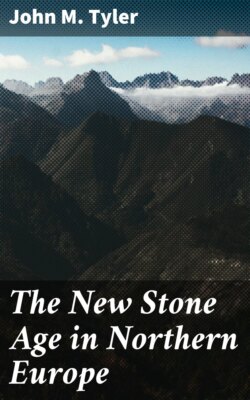The New Stone Age in Northern Europe

Реклама. ООО «ЛитРес», ИНН: 7719571260.
Оглавление
John M. Tyler. The New Stone Age in Northern Europe
The New Stone Age in Northern Europe
Table of Contents
PREFACE
ILLUSTRATIONS
THE NEW STONE AGE. IN NORTHERN EUROPE
THE NEW STONE AGE IN. NORTHERN EUROPE
CHAPTER I. THE COMING OF MAN
CHAPTER II. THE PERIOD OF TRANSITION. SHELL-HEAPS
CHAPTER III. LAND HABITATIONS
CHAPTER IV. LAKE-DWELLINGS
CHAPTER V. A GLANCE EASTWARD
CHAPTER VI. MEGALITHS
CHAPTER VII. NEOLITHIC INDUSTRIES
CHAPTER VIII. NEOLITHIC CHRONOLOGY
CHART I. POSTGLACIAL STAGES. RETREAT OF ICE AND CHANGES
CHART II. CHANGES OF CLIMATE IN DENMARK138
CHAPTER IX. NEOLITHIC PEOPLES AND THEIR. MIGRATIONS
CHAPTER X. NEOLITHIC RELIGION
CHAPTER XI. PROGRESS
CHAPTER XII. THE COMING OF THE INDO-EUROPEANS
BIBLIOGRAPHY
A FEW SUGGESTIONS
GENERAL
CHAPTER I—THE COMING OF MAN
PITHECANTHROPUS
PRIMITIVE HUMAN MIGRATIONS
MAN’S ARRIVAL IN EUROPE
CHAPTER III—LAND HABITATIONS. CAVE-DWELLINGS
HUTS AND VILLAGES
CHAPTER IV—LAKE-DWELLINGS
CHAPTER V—A GLANCE EASTWARD
ORIGIN OF AGRICULTURE AND CATTLE-RAISING
CHAPTER VI—MEGALITHS
DISPOSAL OF DEAD
CHAPTER VII—NEOLITHIC INDUSTRIES
CHAPTER VIII—NEOLITHIC CHRONOLOGY
CHAPTER IX—NEOLITHIC PEOPLES AND THEIR MIGRATIONS. ATLASES
FOR EFFECTS OF GEOGRAPHIC ENVIRONMENT
CHAPTER X—NEOLITHIC RELIGION
CULT OF GODDESS AND MOTHER-RIGHT
CHAPTER XI—PROGRESS
CHAPTER XII—THE COMING OF THE INDO-EUROPEANS
INDEX
Отрывок из книги
John M. Tyler
Published by Good Press, 2019
.....
At this time, during the Pliocene Epoch, there were being deposited in India the so-called Siwalik strata—vast, ancient flood-plains, stretching for a distance of 1,500 miles along the southern foot-hills of the Himalayas. They are composed of materials washed down from the mountains by a system of rivers, persisting with little change into the present. Says Osborn of the mammals found here: “It is altogether the grandest assemblage of mammals the world has ever seen, distributed through southern and eastern Asia, and probably, if our vision could be extended, ranging westward toward Persia and Arabia into northern Africa. It is the most truly cosmopolitan aggregation because in its Upper Pliocene stage it represents a congress of mammals from four great continents. … The only continents which do not contribute to this assemblage are South America and Australia.”11 The older, Miocene, portions of this fauna are chiefly browsing forest forms, emphasized by the absence of both horses and Hipparion, as well as of grazing types of cattle and antelopes. Grazing forms, showing the decline of the forest and the spread of open parkland and grassy areas, become abundant during the Pliocene Epoch. “Among the Primates we find the Orang, an ape now confined to Borneo and Sumatra; also the Chimpanzee, another ape, now confined to Africa, the Siwalik species displaying a more human type of dentition than that of the existing African form.”
In the older, Miocene, portion we find Sivapithecus, an ape which Pilgrim considers as more nearly resembling man than any other genus of anthropoids, while Gregory speaks of it as belonging to the anthropoid line.12 Somewhat later, in late Pliocene or early Pleistocene, there was living not far away, in Java, a far more renowned form, Pithecanthropus erectus, Du Bois, which seems to stand almost exactly midway between higher apes and man. The remains consisted of two molar teeth, a thigh-bone, and the top of a skull. The cranium is low, the forehead exceedingly retreating, giving but very small space for the frontal lobes of the brain. But the brain-cast, made from the cranial cavity, shows, according to Du Bois, that the speech area is about twice as large as in certain apes, though only one-half as large as in man. In size the brain stands somewhat above midway between the highest recent apes and the lowest existing men. The thigh-bone shows that Pithecanthropus could have stood and walked erect quite comfortably. There has been and still is much difference of opinion regarding the position of this most interesting being. Opinion was long divided nearly equally between those who considered it as the highest ape and others who held it to be the very lowest man.
.....